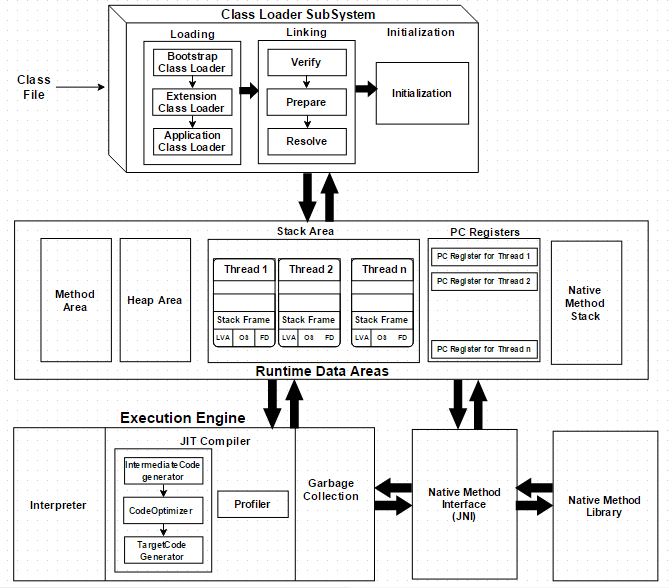Java 21 has arrived, and it’s not just another incremental update; it’s a landmark Long-Term Support (LTS) release that fundamentally redefines how developers approach concurrency and performance on the JVM. Moving on from the solid foundations of previous LTS versions like Java 11 and Java 17, Java 21 delivers a suite of finalized features, most notably from Project Loom, that promise to simplify concurrent programming, boost application throughput, and enhance developer productivity. This release is a major event in the world of Java news, signaling a new era for building scalable, resilient, and maintainable applications.
For years, the Java community has grappled with the complexities of asynchronous programming and the limitations of traditional OS-level threads. Java 21 directly addresses these pain points with the introduction of Virtual Threads and Structured Concurrency. These features are not just theoretical concepts; they are practical tools that will have a profound impact across the entire Java ecosystem news, influencing everything from Spring Boot news and microservices architecture to data-intensive applications. In this article, we will take a comprehensive look at the key features of Java 21, providing practical code examples, best practices, and insights into how this release will shape the future of software development.
The Revolution in Concurrency: Project Loom Comes to Life
The most anticipated and transformative part of Java 21 is the finalization of features from Project Loom. This project’s primary goal was to drastically improve the ease of writing, maintaining, and observing high-throughput concurrent applications. The latest Project Loom news confirms that its core components, Virtual Threads and Structured Concurrency, are now ready for production, marking a significant milestone in Java concurrency news.
Understanding Virtual Threads
For decades, Java threads have been a thin wrapper around operating system (OS) threads, often called “platform threads.” These are heavyweight resources; creating one is expensive, and the OS can only handle a few thousand of them before performance degrades due to context-switching overhead. This limitation forced developers into complex, asynchronous, and often hard-to-debug programming models like callbacks or reactive streams (a major topic in Reactive Java news) to achieve high scalability.
Virtual threads change everything. They are extremely lightweight threads managed by the Java Virtual Machine (JVM) itself, not the OS. Millions of virtual threads can be run on a small pool of platform threads. When a virtual thread executes a blocking I/O operation (like a network call or database query), the JVM automatically “unmounts” it from its platform thread and mounts another runnable virtual thread. The original virtual thread is “parked” until its blocking operation completes, at which point it can be mounted again to continue execution. This mechanism delivers the scalability of asynchronous code with the simplicity and readability of traditional, synchronous, blocking code. This is huge for Java performance news and brings the simple “thread-per-request” model back into vogue for modern web applications.
Practical Example: Migrating to Virtual Threads
The beauty of virtual threads lies in their seamless integration. Migrating an existing application that uses an ExecutorService is remarkably simple. Consider a service that processes a large number of concurrent tasks using a traditional cached thread pool.
import java.util.concurrent.ExecutorService;
import java.util.concurrent.Executors;
import java.util.stream.IntStream;
public class VirtualThreadDemo {
// Represents a task that performs a blocking operation, like an API call.
private static void performTask(int taskNumber) {
System.out.println("Executing task #" + taskNumber + " on thread: " + Thread.currentThread());
try {
// Simulate a blocking network call
Thread.sleep(1000);
} catch (InterruptedException e) {
Thread.currentThread().interrupt();
}
System.out.println("Completed task #" + taskNumber);
}
public static void main(String[] args) {
// The old way: a pool of heavyweight platform threads.
// This would struggle with 100,000 concurrent tasks.
// try (ExecutorService executor = Executors.newCachedThreadPool()) {
// The Java 21 way: an executor that creates a new virtual thread for each task.
// This can handle millions of concurrent tasks with ease.
System.out.println("Starting tasks with Virtual Threads...");
try (ExecutorService executor = Executors.newVirtualThreadPerTaskExecutor()) {
IntStream.range(0, 100_000).forEach(i -> {
executor.submit(() -> performTask(i));
});
} // The executor is automatically closed here.
System.out.println("All tasks submitted.");
}
}
In this example, the only change required is switching from Executors.newCachedThreadPool() to Executors.newVirtualThreadPerTaskExecutor(). This single line change allows the application to handle 100,000 concurrent blocking tasks without running out of threads, a feat that would be impossible with platform threads. This is a game-changer for the entire JVM news landscape.

Taming the Chaos with Structured Concurrency
While virtual threads make concurrency cheap, they don’t solve the problem of managing the lifecycle and inter-dependencies of concurrent tasks. Traditional concurrency models using `Future` often lead to unstructured code where tasks can outlive their parent scope, leading to resource leaks, difficult error handling, and complex cancellation logic. The latest Java structured concurrency news introduces a preview feature in Java 21 to solve this.
Introducing `StructuredTaskScope`
Structured Concurrency treats multiple tasks running in different threads as a single unit of work. The core idea is that if a task splits into multiple concurrent subtasks, they must all complete before the main task can proceed. This is enforced by a lexical scope, typically a `try-with-resources` block. The `StructuredTaskScope` API is the entry point for this model. When you create a scope, you can `fork()` multiple subtasks within it. The `join()` method blocks until all forked tasks are complete, and the `close()` method (called automatically by `try-with-resources`) ensures that no subtask can outlive the scope.
Code in Action: Concurrently Fetching User and Order Data
Imagine a web service that needs to fetch a user’s profile and their order history from two different microservices to build a response. These two network calls can be made concurrently. Using `StructuredTaskScope`, we can do this reliably and robustly.
import java.time.Duration;
import java.util.concurrent.Callable;
import java.util.concurrent.ExecutionException;
import java.util.concurrent.StructuredTaskScope;
import java.util.function.Supplier;
public class StructuredConcurrencyDemo {
// A record to hold the combined response
public record UserData(String userProfile, String orderHistory) {}
// A mock service call that can fail
private String fetchUserProfile() throws InterruptedException {
System.out.println("Fetching user profile...");
Thread.sleep(Duration.ofMillis(300));
// Uncomment to simulate failure
// if (true) throw new RuntimeException("User service unavailable");
return "{\"name\": \"Alex\", \"email\": \"alex@example.com\"}";
}
// A mock service call
private String fetchOrderHistory() throws InterruptedException {
System.out.println("Fetching order history...");
Thread.sleep(Duration.ofMillis(500));
return "[{\"orderId\": 101, \"amount\": 99.99}]";
}
// The method that uses structured concurrency
public UserData fetchUserData() throws InterruptedException, ExecutionException {
// ShutdownOnFailure ensures that if one task fails, the other is cancelled.
try (var scope = new StructuredTaskScope.ShutdownOnFailure()) {
// Fork the first task. It runs in a new virtual thread.
Supplier<String> userProfileFuture = scope.fork(this::fetchUserProfile);
// Fork the second task. It also runs in a new virtual thread.
Supplier<String> orderHistoryFuture = scope.fork(this::fetchOrderHistory);
// Wait for both tasks to complete or for one to fail.
scope.join();
// If one failed, this will throw an exception.
scope.throwIfFailed();
// If both succeeded, retrieve the results and combine them.
return new UserData(userProfileFuture.get(), orderHistoryFuture.get());
}
}
public static void main(String[] args) {
try {
StructuredConcurrencyDemo service = new StructuredConcurrencyDemo();
UserData data = service.fetchUserData();
System.out.println("Successfully fetched data: " + data);
} catch (ExecutionException | InterruptedException e) {
System.err.println("Failed to fetch data: " + e.getMessage());
}
}
}
This code is much cleaner and safer than using `CompletableFuture`. If `fetchUserProfile()` fails, the scope immediately cancels the `fetchOrderHistory()` task (if it’s still running) and the `join()` method returns. The `throwIfFailed()` call then propagates the error, ensuring clean and predictable error handling. This is a powerful pattern that provides some much-needed Java wisdom tips news for concurrent application design.
Beyond Concurrency: Key Language and API Enhancements
While Project Loom steals the spotlight, Java 21 also brings a host of other valuable improvements that enhance the core language and libraries, making day-to-day coding more pleasant and less error-prone. These updates are important for anyone following Java SE news.
Sequenced Collections: A Long-Awaited Interface
A common frustration for Java developers has been the lack of a unified interface for collections that have a defined encounter order (like `List` or `LinkedHashSet`). To get the first or last element, you had to use different methods depending on the specific implementation. Java 21 introduces the `SequencedCollection` interface, which is retrofitted onto existing collection classes and provides a standard API for these operations.

import java.util.ArrayList;
import java.util.List;
import java.util.SequencedCollection;
public class SequencedCollectionDemo {
public static void main(String[] args) {
// ArrayList now implements SequencedCollection
List<String> list = new ArrayList<>();
list.add("First");
list.add("Middle");
list.add("Last");
// Cast to the new interface to use its methods
SequencedCollection<String> sequencedList = list;
// New, unified methods
System.out.println("First element: " + sequencedList.getFirst()); // "First"
System.out.println("Last element: " + sequencedList.getLast()); // "Last"
// Get a reversed view of the collection without modifying the original
SequencedCollection<String> reversedView = sequencedList.reversed();
System.out.println("Reversed view: " + reversedView); // "[Last, Middle, First]"
// The original list remains unchanged
System.out.println("Original list: " + sequencedList); // "[First, Middle, Last]"
}
}
Finalized: Pattern Matching for `switch` and Record Patterns
Evolving from preview features in Java 17, 19, and 20, pattern matching for `switch` is now a final feature. This significantly enhances the power and expressiveness of `switch` statements and expressions, allowing them to operate on the type and structure of objects, not just primitive values. This reduces boilerplate `instanceof` checks and casts, making code safer and more readable. This is great news for the Java self-taught news community, as it makes complex conditional logic much more intuitive.
// Using a record for concise data representation
record Point(int x, int y) {}
public class PatternMatchingDemo {
static void processShape(Object shape) {
// This switch is now a final feature in Java 21
switch (shape) {
case null -> System.out.println("Shape is null!");
// Type pattern with a variable 's'
case String s -> System.out.println("A string: " + s);
// Record pattern to deconstruct the Point object
case Point(int x, int y) ->
System.out.println("A point at x=" + x + ", y=" + y);
// Type pattern with a 'when' clause (guard)
case Integer i when i > 100 ->
System.out.println("A large integer: " + i);
case Integer i ->
System.out.println("A small integer: " + i);
default -> System.out.println("Unknown shape");
}
}
public static void main(String[] args) {
processShape("Hello Java 21");
processShape(new Point(10, 20));
processShape(42);
processShape(200);
processShape(null);
}
}
Ecosystem Impact, Best Practices, and Future Outlook
Java 21’s features are already being adopted across the ecosystem. The latest Spring Boot news is that Spring Boot 3.2+ offers first-class support for virtual threads, allowing you to enable them with a single configuration property. This instantly makes Spring-based web applications more scalable. Similarly, we can expect updates in Hibernate news and other data access libraries to better leverage virtual threads by ensuring their internal operations are non-pinning. Build tools like Maven and Gradle fully support building and running projects with Java 21, and testing frameworks like JUnit 5 are fully compatible.
Best Practices for Adopting Virtual Threads
To get the most out of Java 21, consider these tips:

- Do Not Pool Virtual Threads: Virtual threads are cheap to create, so the old practice of pooling threads is an anti-pattern. Create a new virtual thread for each task. Use
Executors.newVirtualThreadPerTaskExecutor(). - Beware of `synchronized` Blocks: A long-running `synchronized` block can “pin” a virtual thread to its platform thread, preventing the platform thread from being used by other virtual threads. This can create a bottleneck. Prefer using
java.util.concurrent.ReentrantLockover `synchronized` for long-held locks. - Update Your Dependencies: Ensure your libraries and frameworks are updated to versions that are aware of and optimized for virtual threads. This is crucial for performance and stability.
A Glimpse into the Future
Java’s innovation doesn’t stop here. The future holds even more exciting developments. Project Panama news points to a mature Foreign Function & Memory API, making it easier to interoperate with native code. Meanwhile, Project Valhalla news continues to progress on value objects and primitive classes, which could revolutionize memory layout and performance for data-heavy applications. The vibrant OpenJDK news cycle, supported by vendors like Oracle, Red Hat, and distributions like Adoptium news, Azul Zulu news, and Amazon Corretto news, ensures that Java will continue to evolve at a rapid pace.
Conclusion: A New Chapter for Java
Java 21 is arguably the most significant LTS release since Java 8. It delivers on the long-standing promise of making high-performance concurrent programming simple and accessible to all developers. By embracing virtual threads, developers can write straightforward, blocking code that scales massively, effectively closing the gap with platforms like Go and Node.js in terms of I/O-bound concurrency. Structured Concurrency provides the safety and observability needed to manage this newfound power, while language enhancements like sequenced collections and pattern matching continue to refine the developer experience.
For developers currently on Java 8, 11, or 17, the leap to Java 21 offers compelling reasons to upgrade. The performance gains and code simplification are too significant to ignore. The era of complex asynchronous code is giving way to a simpler, more maintainable, and highly scalable paradigm. It’s an exciting time to be a Java developer, and Java 21 is the foundation for the next generation of applications on the JVM.

